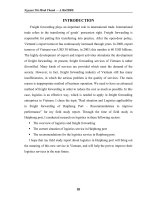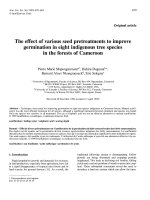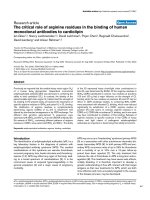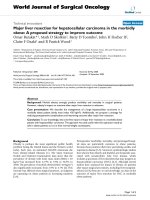Real situation and Logistics applicability in freight forwarding of Haiphong Port – Recommendations to improve performance.doc
Bạn đang xem bản rút gọn của tài liệu. Xem và tải ngay bản đầy đủ của tài liệu tại đây (299.66 KB, 30 trang )
Nguyen Thi Minh Thanh A1K42BBE–
INTRODUCTION
Freight forwarding plays an important role in international trade. International
trade refers to the transferring of goods’ possession right. Freight forwarding is
responsible for putting this transferring into practice. After the open-door policy,
Vietnam’s export turnover has continuously increased through years. In 2000, export
turnover of Vietnam was USD 30 billions, in 2003; this number is 60 USD billions.
The highly development of export and import activities stimulates the development of
freight forwarding. At present, freight forwarding services of Vietnam is rather
diversified. Many kinds of services are provided which meet the demand of the
society. However, in fact, freight forwarding industry of Vietnam still has many
insufficiencies, in which the serious problem is the quality of services. The main
reason is inappropriate method of business operation. We need to have an advanced
method of freight forwarding in order to reduce the cost as much as possible. In this
case, logistics is an effective way, which is needed to apply in freight forwarding
enterprises in Vietnam. I chose the topic “Real situation and Logistics applicability in
freight forwarding of Haiphong Port – Recommendations to improve performance”
for my field study report. Through the time of field study in Haiphong port, I
conducted research on logistics in these following sectors:
The overview of logistics and freight forwarding
The current situation of logistics service in Haiphong port
The recommendations for the logistics service in Haiphong port.
I hope that my field study report about logistics in Haiphong port will bring out the
meaning of this new service in Vietnam, and will help the port to improve their
logistics services in the near future.
III
Nguyen Thi Minh Thanh A1K42BBE–
LIST OF ABBREVIATIONS
EDI: Electronic Data Interchange
ADSL: Asymmetric Digital Suberibers Lines
LCL: Less than container load
FCL: Full container load
PL: Provider of logistics
VIFFAS: Vietnam Freight Forwarding Association
III
Nguyen Thi Minh Thanh A1K42BBE–
CHAPTER 1: OVERVIEW OF FORWARDING AND LOGISTICS
1.1. Freight forwarding
1.1.1. Definition.
Freight forwarding is the process of moving cargo from one place to a destination,
according to the demand of customers.
An international freight forwarder is an agent for the exporter in moving cargo to
an overseas destination. Freight forwarders assist exporters in preparing price
quotations by advising on freight costs, port charges, consular fees, costs of special
documentation, insurance costs, and their handling fees. They recommend the packing
methods that will protect the merchandise during transit or can arrange to have the
merchandise packed at the port or containerized. If the exporter prefers, freight
forwarders can reserve the necessary space on a vessel, aircraft, train, or truck. The
cost for their services is a legitimate export cost that should be included in the price
charged to the customer.
1.1.2. Typical services of freight forwarding
Since Vietnam opened the door to develop economy, especially with the entry in
WTO in 2007, local and foreign shippers have concerns over just how competitive the
country will be, given huge challenges to its freight forwarding industry. Therefore,
freight forwarding service has been highly developing.
A freight forwarder can offer a variety of services.
• Advising on the best routes and relative shipping or airline.
• Booking the necessary space with shipping or airline.
• Arranging with the exporter for the packing and marketing of the goods.
• Consolidating shipment from different exporters.
• Handling customs clearance abroad.
• Arranging marine insurance for the shipment.
• Preparing the export documentation.
• Translating correspondence in foreign language
• Scrutinizing and advertising on ability to comply with letter of credit.
III
Nguyen Thi Minh Thanh A1K42BBE–
Once the order is ready for shipment, freight forwarders review all documents to ensure
that everything is in order. This is of particular importance with letter of credit payment
terms. They may also prepare the bill of lading and any special required documentation. After
shipment, they can route the documents to the seller, the buyer, or to a paying bank. Freight
forwarders can also make arrangements with customs brokers overseas to ensure that the
goods comply with customs export documentation regulations. A customs broker is an
individual or company that is licensed to transact customs business on behalf of others.
Customs business is limited to those activities involving transactions related to the entry and
admissibility of merchandise; its classification and valuation; the payment of duties, taxes, or
other charges assessed or collected; or the refund, rebate, or drawback thereof. According to
its size, number of branches overseas, a freight forwarder will offer all or some of these
services.
1.2.Logistics.
1.2.1. Definition.
Logistics refers to the management of the physical flow of products from the point
of original as raw materials to end users as finished product. Logistics wed production
activities to the activities needed of transportation, storage, and distribution.
According to definition of Logistics, the process is described in the below chart:
Raw materials→Raw materials →Manufacturing→Finished goods→Market
Supply point Storage
1.2.2. Logistics flow.
Logistics deals with geography, time and value. Moving from source to
destination, freight and transportation connects buyer to seller and make the final
delivery. In this process, there are number of stages involved. Freight and
transportation alone encompasses many modes including truck, sea, rail, and air, all
with varying issues, costs and levels of service. The flow chart below illustrates the
process, which involves the input of these services providers in the movement of a
particular product from the point it leaves the plant to end consumer in a retail outlet.
Figure 1.1 Logistics flow
III
Nguyen Thi Minh Thanh A1K42BBE–
(Source: Hausman, Warren H. 2004 . “Supply Chain Performance Measures.” In
Corey Billington, Terry Harrison, Hau Lee, and John Neale, eds., The Practice of
Supply Chain Management.)
Businesses and organizations address their logistics requirements by assigning staff
to perform logistics activities by outsourcing one or several functions to third – party
providers.
In house logistics department usually manned by full- time logisticians who perform
logistics- related functions. Their positions include purchasing managers,
transportation managers, custom brokers, shippers and receivers. In the absence of
outsourcing options, companies have dealt with moving and storing of goods in a
disparate ways. Although outsourcing of logistics services is a fairly emerging trend,
there are a large number of firms that maintain their own in- house logistics or
distribution departments. This is largely prevalent in the manufacturing, commodity
sectors, wholesaling and retailing.
1.2.3. Fundamental elements of logistics
III
Nguyen Thi Minh Thanh A1K42BBE–
Logistics includes such fundamental elements:
Transportation: This is the most important element of logistics. In order to
reduce the cost of logistics, it is necessary to reduce the cost of transportation
from the manufacturing places to different markets. Transporting process must
be done smoothly to make the delivery of goods or supply required materials
on time, minimize the inventory cost.
Marketing: Logistics includes making plans, implementing it and controlling
the delivery of goods from the point of original as raw materials to end users as
finished products. Therefore, it is clear that all the services focus on customers
and meet the demand of customers. Effective marketing strategies help
managers to have good customer services, deliver right products to right places
and right customers.
Distribution: An effective distribution channel can reduce the cost of logistics.
It is necessary for managers to combine two factors: right place and right time
to create an optimal distribution channel.
Management: It also plays an important role in logistics. Lack of management
factor, logistics services cannot meet the requirements of the customers as well
as the objectives of the firms. Therefore, logisticians must have expertise or
thorough understanding about transport modals, transport cost, and warehouse.
Beside such important elements above, logistics also include following elements,
which is not less important:
Warehouses, factories
Technical document
Supporting and supervising equipment
Human resources and staff training
1.2.4. Benefits from improved logistics
1.2.4.1. Reduces the cost for consumer and producer
Logistics is “the process of planning, implementing and controlling the efficient,
III
Nguyen Thi Minh Thanh A1K42BBE–
cost-effective flow and storage of raw materials, in-process inventory, finished goods,
and related information from point of origin to point of consumption for the purpose
of conforming to customers’ requirement”. So, logistics reduces the cost of
transferring goods between markets and of course it will reduce the prices paid by
consumers . On the consumers’ side, this effect can be seen most clearly by examining
the price of goods at the port relatived to the price of goods inland. Producers will not
ship goods inland unless the prices they receive, net of shipping, is at least as high as
prices at the port. This means that inland consumers bear the full burden of shipping
costs for goods that is not produced locally. This burden can be substantial.
A similar logic applies to exports. International markets will not pay more for
goods produced in inland regions, and so the ex- factory or ex- farm prices are
reduced by the full inland logistics costs of access to the port.
1.2.4.2. Insurance against regional price fluctuations.
When agricultural output varies because of unpredictable weather, one region may
experience drought and food shortages while another enjoys sufficient rainfall and
ample harvests. If the regions are separated by poor logistics and transport systems,
consumers in the shortfall region face very high prices for food, while producers in the
surplus region face a market glut. Regional variations in agricultural prices are
especially pronounced within country like Vietnam, in which interior regions are
poorly connected or inaccessible. Good internal logistics facilitates surplus
commodity shipments from surplus to shortfall regions, smoothing prices variations
between them and providing a kind of insurance against shortage and glut. Better
market access appears to dampen price volatility for a broad range of products.
Validity in goods prices between city pairs riser with the distance between the cities,
and is especially large for city pairs across national borders. Essentially, arbitrage is
necessary to narrow price differentials across locations, and this is much harder to
achieve when logistics are poor.
1.2.4.3. Reduced inventory costs.
III
Nguyen Thi Minh Thanh A1K42BBE–
Better transport and logistics system not only lower the costs of delivery, but also
make the timing of delivery more reliable. Producers cannot manufacture goods
without the inputs they need, and retailers cannot sell goods they do not have in stock,
so if delivery times are uncertain, firms must hold large inventories of goods. The first
reason for long and uncertain delivery times is poor infrastructure – roads may be
impassable, and railways nonexistent, or roads may cause damage to trucks that
involve high costs and long delays. Another reason is peak load congestion – a severe
problem in areas where population and manufacturing intensity have grown faster
than infrastructure capacity. In Ho Chi Minh City, for example, the government bans
trucks heavier than 2 tons in the inner city between 6 a.m. and 6 p.m. to combat
growing traffic congestion, and thus manufacturers must hold large inventories all day
rather than delivery midday shipments, and trucks sit idle during the day. This
contrasts with modern just- in - time techniques, in which deliveries are continuous,
and the transport capital stock is in constant use. Leaner production techniques require
a substantial flow of information. Manufacturing firms can only run with small
inventories of inputs if they are certain where and when the next shipment will arrive.
In turn, this requires sophisticated electronic data interchange.
1.2.4.4. More developed markets.
Well-developed logistics increase consumers’ choice and producers’ sources of
supply, and bring more markets within producers’ reach. According to the statistics of
International Exhibition Logistics Associates, 40% of trade growth in East Asia arises
from offering new product lines and extending exports of existing product lines to
new trading partners.
Products diversification benefits both agricultural- and industrial- based economies,
since for both specialization in narrow range of products can be dangerous because of
prices volatility. According to the Global Competitiveness Report 2005-2006 (World
Economic Forum), most of the differences in trade levels between small and large
economies can be attributed to differences in the range of goods that are traded, and
that much of the growth in imports that results from lowering trade costs come
III
Nguyen Thi Minh Thanh A1K42BBE–
through expansions in the set of products available. The welfare benefits from
expended product variety can dwarf those from standard calculations of the gains
from trade.
Better logistics allow variety expansion in several ways. First, they may directly
lower the fixed cost of expansion. There are significant scale advantages to providing
transport hubs, warehousing, and logistics services that many firms can share. Second,
by lowering the marginal costs of serving markets, it is possible to increase sales and
spread entry costs over more units.
The diversification argument also applies across markets, as reliance on single export
destinations leaves firms subject to significant business cycle risks.
CHAPTER 2: HAIPHONG PORT AND LOGISTICS SERVICES
2.1. Overview of Haiphong port
2.1.1. Establishment and development
III
Nguyen Thi Minh Thanh A1K42BBE–
Haiphong ports was founded in 1876, with original name is Ben Sau Kho. Over
121 years of existence and development, port of Haiphong has always played the most
important role of the “Border gate” interface in the North of Vietnam. Import and
export cargoes to and from North of Laos and South of China, have been transferred
via Haiphong Port to the markets of many countries and vice versa. Haiphong port has
the biggest cargoes throughput among the ports in the North of Vietnam. The port is
equipped with modern facilities and equipments and has safe, sufficient infrastructure
which meets all international modes of transport and trade. The estimated cargo
throughput of Haiphong Port in the 2005- 2010 period is from 12.000.000 tons to
18.000.000 ton per year.
The Head Quater is at number 8A Tran Phu Street, Ngo Quyen district, Haiphong
city.
2.1.2. Scope of business activities
In Haiphong port, handling operation areas are located based on the infrastructure
advantages such as railway, high way, and inland waterway. These areas are installed
and equipped with modern and advanced handling equipments which are suitable to
every kind of cargoes, meeting the demand for different models of transport.
Main services of Haiphong port:
Cargo handling, forwarding and logistics.
Ship towage and assistance
International container transshipment
Forwarding and transporting agent
Transporting containers from Haiphong to Laocai and vice versa by railway
Bagging, packing, and transporting cargoes by sea, highway, and inland
waterways.
Ship agent and marine brokerage
2.1.3. Organizational structure
Haiphong port is operated like a big state-owned company. The leader of Haiphong
port is General Director who is responsible for all activities in the Haiphong port.
III
Nguyen Thi Minh Thanh A1K42BBE–
There are four Deputy General Directors who support General Director in four
sectors: business, operation, engineering, and port rehabilitation project. Separating to
the General Director and Deputy General Directors are functional departments. For
example, Business department, Accounting department, Technical department, Agent
shipping and brokerage department, Human resources department, etc. Besides these
functional departments, Haiphong port has five enterprises which mostly responsible
for cargo handling services. They are: Hoang Dieu, Le Thanh Tong, Chua Ve and
Bach Dang Stevedoring Enterprise. Each functional department is controlled by a
manager.
2.1.4. Situation of business activities
Haiphong port continuously improves its methods of providing services to
customers, increases handling productivity, cuts short procedures of cargo delivery
and receipt as well as applies advanced methods of management in order to enhance
the quality of services, minimize cost and time for customers. Therefore, Haiphong
port’s throughput has increased through years.
Table 2.1 Haiphong port throughput from 2001-2006
2001 2002 2003 2004 2005 2006
Export
throughput
1,336,393 1,365,476 1,757,845 1,792,446 2,349,119 2,925,092
Import
throughput
4,357,606 5,266,554 5,401,516 5,365,624 5,196,931 5,198,669
Domestic
thoughput
2,881,513 3,669,293 3,358,601 3,325,623 2,965,007 3,127,601
(Source:Annual report of Haiphong port’s business department -unit:billion tons)
III









